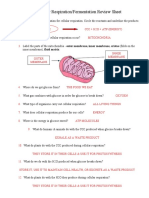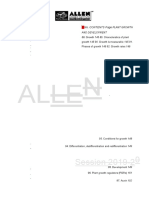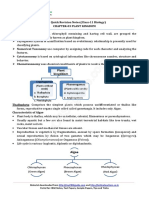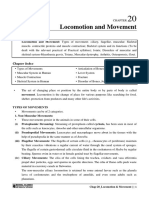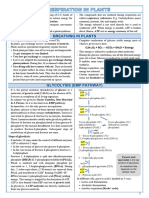Respiration in Plants
Respiration in Plants
Uploaded by
janakiramannadesanCopyright:
Available Formats
Respiration in Plants
Respiration in Plants
Uploaded by
janakiramannadesanCopyright
Available Formats
Share this document
Did you find this document useful?
Is this content inappropriate?
Copyright:
Available Formats
Respiration in Plants
Respiration in Plants
Uploaded by
janakiramannadesanCopyright:
Available Formats
CHAPTER
anand_mani16 Dr. Anand Mani https://www.anandmani.com https://discord.io/anandmani t.me/anandmani001
• Oxidation of food materials (breaking of C-C bonds of complex
molecules) within the cell to release energy for ATP synthesis
is called cellular respiration.
• This energy is used for absorption, transport, movement,
reproduction, breathing etc.
• Ultimate source of food that is respired is photosynthesis.
• The compounds that are oxidized during respiration are called
respiratory substrates. E.g. Carbohydrates (most common),
proteins, fats and organic acids.
• The energy released is not used directly but is used to
synthesize ATP. When energy is needed, ATP is broken down.
Hence, ATP acts as energy currency of the cell.
• For respiration, plants get O2 and give out CO2.
• In plants, gas exchange occurs via stomata & lenticels.
• Plants need no specialized respiratory organs because Each plant part takes care of its own gas-exchange needs.
So gas transport is very limited. Very low gas exchange as compared to that of animals. Leaves are adapted for
maximum gas exchange during photosynthesis. During this, O2 is released within the cell. Most living cells have
contact with air. They are located close to plant surface. In stems, living cells are organized in thin layers beneath
the bark. They also have lenticels. In leaves, stems & roots, parenchyma cells are loosely packed that provides
interconnected air spaces.
• Complete combustion of glucose yields energy most of which is given out as heat.
6H12O6 + 6O2 → 6CO2 + 6H2O + Energy
• This energy is utilized to synthesize other molecules.
• During the glucose catabolism, not all the liberated energy goes out as heat. Glucose is oxidized in several small
steps. It enables some steps to couple released energy to ATP synthesis.
• During respiration, oxygen is utilized, and CO2, water & energy are released.
• Certain organisms are adapted to anaerobic conditions. Some are facultative anaerobes. Others are obligate.
• It is the partial oxidation (breakdown) of glucose to 2 molecules of
pyruvic acid (C3H4O3) in the absence of O2.
• It occurs in cytoplasm of all living organisms.
• Its scheme was given by Gustav Embden, Otto Meyerhof & J. Parnas.
So it is also known as EMP pathway.
• In anaerobes, it is the only process in respiration.
• In plants, glucose is derived from sucrose (end product of
photosynthesis) or from storage carbohydrates. Sucrose is converted
into glucose & fructose by an enzyme, invertase. .
These 2 monosaccharides readily enter glycolytic pathway.
• Glucose & fructose are phosphorylated to form glucose-6-phosphate
by the enzyme hexokinase. It is then isomerized to produce
fructose-6-phosphate. Subsequent steps of metabolism of glucose
and fructose are same.
• It includes 10 steps under the control of different enzymes.
• ATP is utilized at 2 steps:
• In the conversion of glucose into glucose 6-phosphate. In the
conversion of fructose 6-phosphate to fructose 1, 6-diphosphate.
• Fructose 1, 6-diphosphate is split into dihydroxyacetone phosphate
and 3-phosphoglyceraldehyde (PGAL).
anand_mani16 Dr. Anand Mani https://www.anandmani.com https://discord.io/anandmani t.me/anandmani001
- PGAL is oxidized and with inorganic phosphate get converted
to 1, 3-bisphosphoglycerate (DPGA). During this, 2 redox-
equivalents (2 H-atoms) are removed from PGAL and
transferred to NAD+ forming NADH + H+ .
- DPGA becomes 3-phosphoglyceric acid (PGA) yielding
energy. This energy is trapped by the formation of ATP.
- ATP is also formed when PEP converts to pyruvic acid.
- In glycolysis, 4 ATP molecules are directly synthesized
from one glucose molecule. In different cells, pyruvic acid
is handled in 3 ways:
Lactic acid fermentation.
Alcoholic fermentation.
Aerobic respiration (Krebs’ cycle).
- It is the incomplete oxidation of glucose under anaerobic condition.
- It occurs in many prokaryotes and unicellular eukaryotes.
- It is 2 types:
Alcoholic fermentation: Here, the pyruvic acid formed from glucose is
converted to CO2 and ethanol. The enzymes, pyruvic acid decarboxylase
and alcohol dehydrogenase catalyze these reactions. E.g. Yeast.
Yeasts poison themselves to death when the concentration of alcohol
reaches about 13%.
Lactic acid fermentation: Here, pyruvic acid is converted to lactic acid.
E.g. Some bacteria.
- The reducing agent (NADH+H+) is reoxidized to NAD+ in both the
processes.
- In animals, when oxygen is inadequate during exercise, pyruvic acid
in muscle cells is reduced to lactic acid by lactate dehydrogenase.
- Net ATP production from fermentation of one glucose
molecule = 2. (4 ATP from glycolysis – 2 ATP utilized).
- The steps involved in fermentation are shown below:
Energy production is limited. Less than 7% of the energy in glucose is released
and not all of it is trapped as high energy bonds of ATP.
Hazardous products (acid or alcohol) are formed
- It is a complete oxidation of organic substances in the presence of oxygen releasing CO2, water &energy.
- It occurs in mitochondria.
- For this, the pyruvate (final product of glycolysis) is transported from the cytoplasm into the mitochondria.
- The crucial events in aerobic respiration are:
Complete oxidation of pyruvate by stepwise removal of all the hydrogen atoms, leaving 3 CO2 molecules. It takes
place in the matrix of mitochondria.
Passing on of electrons removed as part of H-atoms to molecular O2 with simultaneous synthesis of ATP. It
occurs on the inner membrane of mitochondria.
- Pyruvate (pyruvic acid) enters mitochondrial matrix and undergoes oxidative decarboxylation in presence pyruvic
dehydrogenase. It needs coenzymes, NAD+ & Coenzyme A.
- During this process, 2 NADH molecules are produced from 2 pyruvic acid molecules.
- During this process, 2 NADH molecules are produced from 2 pyruvic acid molecules.
- Acetyl CoA then enters tricarboxylic acid (TCA) cycle.
anand_mani16 Dr. Anand Mani https://www.anandmani.com https://discord.io/anandmani t.me/anandmani001
TCA cycle was first elucidated by Hans Krebs.
Steps:
1. Condensation of acetyl group with oxaloacetic acid (OAA)
& water to form citric acid in presence of citrate synthase
enzyme. A CoA molecule is released.
2. Citrate is isomerized to isocitrate.
3. Decarboxylation of isocitrate to a -ketoglutaric acid.
4. Decarboxylation of a-ketoglutaric acid to succinyl-CoA.
5. Succinyl-CoA is converted to succinic acid and a GTP
molecule is synthesized (substrate level phosphorylation).
In a coupled reaction, GTP is converted to GDP with
simultaneous synthesis of ATP from ADP.
6. Oxidation of succinate to Fumarate and then to Malate.
7. Oxidation of malate to OAA.
• At 3 points of TCA cycle, NAD+ is reduced to NADH + H+. At
one point, FAD+ is reduced to FADH2.
• Continued oxidation of acetic acid via TCA cycle requires
continued replenishment of OAA. It also requires
regeneration of NAD+ & FAD+ from NADH & FADH2.
6. Summary equation for this phase is given aside
Thus, a glucose is broken down to give 6 CO2, 8 NADH + H+, 2
FADH2 and 2ATP.
- Electron transport system (ETS) is the metabolic pathway present
in the inner mitochondrial membrane through which electron passes
from one carrier to another.
- This is to release and utilize energy stored in NADH + H+ 2 (formed
during TCA cycle) by oxidation.
- The electrons are passed on to O2 to form H2O.
- Electrons from NADH are oxidized by an NADH ehydrogenase (complex I).
- Electrons are then transferred to ubiquinone (Q) located within the
inner membrane. Ubiquinone also receives reducing equivalents via
FADH2 (complex II) that is generated during oxidation of succinate in
citric acid cycle.
- The reduced ubiquinone (ubiquinol or QH2) is then oxidized with the
transfer of electrons to cytochrome c via cytochrome bc1 complex
(complex III). Cytochrome c is a small protein attached to the outer
surface of the inner membrane. It acts as a mobile carrier of electrons
between complex III and IV.
- Complex IV refers to cytochrome c oxidase complex containing
cytochromes a & a3, and 2 copper centers.
- When the electrons pass from one carrier to another via complex I to
IV, they are coupled to ATP synthase (complex V) for the ATP
production.
- In aerobic respiration, the role of oxygen is limited to the terminal stage. Number of ATP
Yet, oxygen is vital since it drives the whole process by removing molecules produced
hydrogen from the system. Oxygen acts as the final hydrogen acceptor depends on nature of
electron donor.
- In respiration, energy of oxidation-reduction is utilized for the
phosphorylation. So this process is called oxidative phosphorylation. It is Oxidation of
not as photophosphorylation (Here, light energy is utilized for the 1 NADH→ 3 ATP
production of proton gradient for phosphorylation). 1 FADH2→ 2 ATP
anand_mani16 Dr. Anand Mani https://www.anandmani.com https://discord.io/anandmani t.me/anandmani001
- The energy released during the ETS is utilized to synthesize ATP by
ATP synthase (complex V).
- ATP synthase has two major components: F1 & F0.
- F 1headpiece (peripheral membrane protein complex): Site for ATP
synthesis from ADP & inorganic phosphate.
- F0 (integral membrane protein complex): It forms a channel through
which protons cross the inner membrane. The passage of protons is
coupled to the catalytic site of the F1 component for ATP production.
- For each ATP produced, 2H+ passes through F0 from the inter-
Diagrammatic presentation of ATP
membrane space to the matrix down the electrochemical proton synthesis in mitochondria
gradient.
- Net gain of ATP from each glucose molecule is calculated based on the following assumptions.
All steps in Glycolysis, TCA cycle & ETS occur sequentially and orderly.
The NADH synthesized in glycolysis is transferred into mitochondria and undergoes oxidative phosphorylation.
Intermediates in the pathway are not used to synthesize other compounds.
Only glucose is being respired. Other alternative substrates are not entered in the pathway at any stages.
- Such assumptions are not valid because,
o All pathways work simultaneously and do not take place one after another.
o Substrates enter the pathways and are withdrawn from it as and when necessary.
o ATP is utilized as and when needed.
o Enzymatic rates are controlled by multiple means.
- Such calculations are useful to appreciate the efficiency of the living system in extraction and storing energy.
Net gain of ATP molecules from one glucose molecule
2 ATP directly 2 ATP
Glycolysis 2 molecules of NADH 6 ATP
Oxidative 2 NADH 6 ATP
decarboxylation
6 NADH 18 ATP
2 FADH 4 ATP
TCA cycle
2 GTP 2 ATP
Total 38 ATP
2 ATP molecules are spent for transporting 2 NADH molecules formed
during glycolysis to the mitochondria. Hence the net gain = 36 ATP molecules.
Comparison b/w fermentation & aerobic respiration
Fermentation Aerobic respiration
Partial breakdown of Complete breakdown of
glucose. glucose to CO2 & H2O.
Net gain of only 2 ATP. Net gain of 36 ATP.
NADH is oxidised to NADH is oxidised to NAD+ very
NAD+ rather slowly. vigorously.
anand_mani16 Dr. Anand Mani https://www.anandmani.com https://discord.io/anandmani t.me/anandmani001
Glucose is the favored substrate for respiration. So, all
carbohydrates are first converted to glucose for
respiration.
- Other substrates are also respired.
- Fats breakdown into glycerol & fatty acids. Fatty acids
are degraded to acetyl CoA and enter the pathway.
Diagrammatic presentation of ATP
Glycerol is converted to PGAL and enters the pathway. synthesis in mitochondria
- Proteins are degraded by proteases into amino acids.
Each amino acid (after deamination) enters the
pathway at some stage in the Krebs’ cycle or as
pyruvate or acetyl CoA.
- The respiratory pathway is generally considered as a
catabolic pathway. But it involves both anabolism
(synthesis) and catabolism (breakdown). So it is better
called as an amphibolic pathway.
E.g. Fatty acids breakdown to acetyl CoA before entering
the respiratory pathway. But when the organism needs
to synthesize fatty acids, acetyl CoA withdraw from the
respiratory pathway.
Similarly, during breakdown and synthesis of protein,
respiratory intermediates are involved.
- It is the ratio of the volume of CO2 evolved to the volume of O2 consumed in respiration.
RQ = Volume of CO2 consumed
Volume of O2 consumed
- RQ depends upon the type of respiratory substrate.
- RQ for carbohydrates= 1, because equal amounts of CO2 and O2 are evolved and consumed, respectively.
C6H12 O6 + 6O2 → 6CO2 + 6 H2O + energy
RQ = 6 CO2 = 1.0
6 O2
- RQ for fats = < 1. Calculations for a fatty acid, (e.g. tripalmitin) are shown:
2 (C51H98 O6) + 145O2 → 102 CO2 + 98 H2O + energy
RQ = 102 CO2 = 0.7
145 O2
- RQ for proteins = 0.9.
- In living organisms, respiratory substances are often more than one. Pure proteins or fats are never used as
respiratory substrates.
anand_mani16 Dr. Anand Mani https://www.anandmani.com https://discord.io/anandmani t.me/anandmani001
You might also like
- Evolution 1 - Cladograms MinionsDocument2 pagesEvolution 1 - Cladograms MinionsMary Vienne PascualNo ratings yet
- Cellular Respiration - Fermentation Review WorksheetDocument4 pagesCellular Respiration - Fermentation Review WorksheeterikabeltranNo ratings yet
- Physiology - Rhythmical Excitation of Heart by Dr. Mudassar Ali RoomiDocument18 pagesPhysiology - Rhythmical Excitation of Heart by Dr. Mudassar Ali RoomiMudassar Roomi100% (2)
- 14 Respiration in Plants-NotesDocument4 pages14 Respiration in Plants-NotesAnanth DharanidharanNo ratings yet
- RespirationDocument11 pagesRespirationthushyanthNo ratings yet
- Respiration in PlantsDocument22 pagesRespiration in PlantsTabada NickyNo ratings yet
- Respiration in Plants Class 11 Notes NEET Biology (PDF)Document11 pagesRespiration in Plants Class 11 Notes NEET Biology (PDF)soumyajitghosh289No ratings yet
- Neural Control and Coordination Notes For NEET Download PDF - pdf-20Document7 pagesNeural Control and Coordination Notes For NEET Download PDF - pdf-20Legendary KingNo ratings yet
- 27 Plant Growth and DevelopmentDocument59 pages27 Plant Growth and DevelopmentTithee RinayatNo ratings yet
- Photosynthesis in Higher Plant1Document21 pagesPhotosynthesis in Higher Plant1Mehar SinghNo ratings yet
- Photosynthesis Short ConceptsDocument51 pagesPhotosynthesis Short Conceptsauguste noe100% (2)
- 11 Biology Notes ch03 Plant Kingdom PDFDocument5 pages11 Biology Notes ch03 Plant Kingdom PDFakash guptaNo ratings yet
- Revision Worksheet Photosynthesis in Higher Plants: StatementsDocument3 pagesRevision Worksheet Photosynthesis in Higher Plants: StatementsKrishna Nilesh Lodhia G 11No ratings yet
- Photosynthesis in Higher Plants - by @MadXAbhiOfficialDocument11 pagesPhotosynthesis in Higher Plants - by @MadXAbhiOfficialmintukumar696969No ratings yet
- Cell Cycle and Cell Division: (With Revision Tracking)Document5 pagesCell Cycle and Cell Division: (With Revision Tracking)SAMPATH SPNo ratings yet
- CBSE Class 12 Biology Revision Notes Chapter 6 Molecular Basis of InheritanceDocument10 pagesCBSE Class 12 Biology Revision Notes Chapter 6 Molecular Basis of InheritancesahanaNo ratings yet
- Photosynthesis in Higher PlantsDocument7 pagesPhotosynthesis in Higher PlantsAnshuman DashNo ratings yet
- Organic Chemistry - Some Basic Principles and TechniquesDocument16 pagesOrganic Chemistry - Some Basic Principles and TechniquesAbhayNo ratings yet
- Respiration and Circulation: Secondary 2, Biology, Chapter 3Document7 pagesRespiration and Circulation: Secondary 2, Biology, Chapter 3Deddy KismanaNo ratings yet
- Class 11 Biology NotesDocument150 pagesClass 11 Biology NotesreilyshawnNo ratings yet
- Structural Organisation in Animals Revision NotesDocument10 pagesStructural Organisation in Animals Revision NotesHarismita AlagurajNo ratings yet
- Sexual Reproduction in Flowering Plants (Note 2020) Part IDocument11 pagesSexual Reproduction in Flowering Plants (Note 2020) Part IY S BAMMANAL y sNo ratings yet
- 7 Structural Organisation in Animals PPT - Part 5Document22 pages7 Structural Organisation in Animals PPT - Part 5Jeevan RaajNo ratings yet
- Photosynthesis in Higher PlantsDocument25 pagesPhotosynthesis in Higher PlantsRaichal P BijuNo ratings yet
- Photosynthesis in Higher Plants: Class: 11 Sub: Biology Chapter - 13Document7 pagesPhotosynthesis in Higher Plants: Class: 11 Sub: Biology Chapter - 13kuldeep kumarNo ratings yet
- Structural Organisation in AnimalsDocument19 pagesStructural Organisation in AnimalsBiju Mylachal100% (1)
- Molecular Basis of InheritanceDocument33 pagesMolecular Basis of InheritanceJabcv OahdjNo ratings yet
- Excretory System ResonanceDocument40 pagesExcretory System ResonanceEkta ManglaniNo ratings yet
- Important Questions For CBSE Class 12 Chemistry Chapter 3Document16 pagesImportant Questions For CBSE Class 12 Chemistry Chapter 3Kingro SimNo ratings yet
- Theory QuestionsDocument121 pagesTheory Questionsjanakansenthil2010No ratings yet
- CBSE Quick Revision Notes (Class-11 Biology) Chapter-10 Cell Cycle and Cell DivisionDocument4 pagesCBSE Quick Revision Notes (Class-11 Biology) Chapter-10 Cell Cycle and Cell DivisionArnavNo ratings yet
- Study On Methods of Purification of WaterDocument11 pagesStudy On Methods of Purification of WaterJASON SAMUEL.JNo ratings yet
- XII - XAMIDEA - BIOLOGY - Organisms & PopulationsDocument38 pagesXII - XAMIDEA - BIOLOGY - Organisms & Populationskeren spamzNo ratings yet
- 12 Biology Notes Ch10 Microbes in Human WelfareDocument6 pages12 Biology Notes Ch10 Microbes in Human WelfareYash GuptaNo ratings yet
- Breathing and Exchange of GasesDocument25 pagesBreathing and Exchange of GasesSureshNo ratings yet
- CBSE Class 12 Chemistry Chapter 14 - Biomolecules Important Questions 2022-23Document22 pagesCBSE Class 12 Chemistry Chapter 14 - Biomolecules Important Questions 2022-23Archanaa PadmavathiNo ratings yet
- Class 11 Biology Chapter 4 NOTESDocument38 pagesClass 11 Biology Chapter 4 NOTESYashica PradhanNo ratings yet
- Structural Organisation in AnimalsDocument19 pagesStructural Organisation in Animalssrinu.lichflNo ratings yet
- Class 11 Biology Chapter 3 - Revision NotesDocument34 pagesClass 11 Biology Chapter 3 - Revision NotesAnubhav MamgainNo ratings yet
- CBSE Class 12 Biology Revision Notes Chapter-14 Ecosystem: Material Downloaded From - 1 / 8Document8 pagesCBSE Class 12 Biology Revision Notes Chapter-14 Ecosystem: Material Downloaded From - 1 / 8Subhodeep GhoshNo ratings yet
- Topicwise Analysis For Last 10 YearsDocument20 pagesTopicwise Analysis For Last 10 YearsVAMCNo ratings yet
- Molecular Basis of Inheritance QuestionsDocument5 pagesMolecular Basis of Inheritance QuestionsKella OrtegaNo ratings yet
- Spectrum SeriesDocument14 pagesSpectrum SeriesSagar JunejaNo ratings yet
- Photosynthesis in Higher PlantsDocument16 pagesPhotosynthesis in Higher PlantsMohammed ArifuddinNo ratings yet
- Sexual Reproduction in Flowering Plants - NotesDocument6 pagesSexual Reproduction in Flowering Plants - Notessundarchoudhary2020100% (1)
- JR - Inter Botany Model Paper 2Document1 pageJR - Inter Botany Model Paper 2angadibalajithkumarNo ratings yet
- Chap-20 - Locomotion & MovementDocument52 pagesChap-20 - Locomotion & MovementMittal SavaniNo ratings yet
- DPP XI Chapter - 15 Plant Growth and Development 15Document15 pagesDPP XI Chapter - 15 Plant Growth and Development 15Riya MondalNo ratings yet
- Medica Wing Mind Map For Biology NeetDocument80 pagesMedica Wing Mind Map For Biology NeetFaizan AliNo ratings yet
- 12 Biology Notes Ch06 Molecular Basis of InheritanceDocument14 pages12 Biology Notes Ch06 Molecular Basis of Inheritancehimanshu kumarNo ratings yet
- CBSE Class 11 Biology Cell Cycle and Cell Division NotesDocument4 pagesCBSE Class 11 Biology Cell Cycle and Cell Division NotesVansh MehtaNo ratings yet
- 64b2bc5dbcf5cd0018899d93 - ## - Human Health and Diseases Handwritten Notes (Of Lecture 06)Document4 pages64b2bc5dbcf5cd0018899d93 - ## - Human Health and Diseases Handwritten Notes (Of Lecture 06)sourajeetsahoo2610No ratings yet
- Chemicals Coordination and Its Integration - Mind Map - Arjuna NEET 2024Document5 pagesChemicals Coordination and Its Integration - Mind Map - Arjuna NEET 2024aashish.tskauthNo ratings yet
- Principles of Inheritance and VariationDocument16 pagesPrinciples of Inheritance and VariationTulika BholaNo ratings yet
- Notes: - Reproduction in Organisms, For Class 12Document18 pagesNotes: - Reproduction in Organisms, For Class 12Subho BhattacharyaNo ratings yet
- Biological Classification VedantuDocument12 pagesBiological Classification VedantuSebanti Roy ChowdhuryNo ratings yet
- Data Ncert I Full SolutionDocument40 pagesData Ncert I Full Solutionchannel of dhyana100% (1)
- Chemical Coordination and IntegrationDocument47 pagesChemical Coordination and IntegrationDebika ChattopadhyayNo ratings yet
- CLS Aipmt-18-19 XIII Bot Study-Package-3 SET-1 Chapter-10 PDFDocument26 pagesCLS Aipmt-18-19 XIII Bot Study-Package-3 SET-1 Chapter-10 PDFChandana InguvaNo ratings yet
- Respiration in PlantsDocument4 pagesRespiration in Plantscoolakshat3664No ratings yet
- Chapter 14 - RESPIRATION IN PLANTSDocument10 pagesChapter 14 - RESPIRATION IN PLANTSprernatiwary508No ratings yet
- Energy TransformationDocument25 pagesEnergy TransformationHenceNo ratings yet
- Electroencefalografia Introducción PDFDocument96 pagesElectroencefalografia Introducción PDFMaRianaP.EscalonaNo ratings yet
- Status of Organic Agriculture in Sri Lanka With Special Emphasis On Tea Production SystemsDocument127 pagesStatus of Organic Agriculture in Sri Lanka With Special Emphasis On Tea Production SystemsDulasirisenNo ratings yet
- Nursery Plan and Location - PDF Business Plan Proposal 1Document24 pagesNursery Plan and Location - PDF Business Plan Proposal 1Rachel BrionesNo ratings yet
- FELDA - Fertilizer Management and Productivity of Palm Oil in MalaysiaDocument72 pagesFELDA - Fertilizer Management and Productivity of Palm Oil in MalaysiaTulananda100% (1)
- 02 - Amino acids-D2LDocument29 pages02 - Amino acids-D2LLaKazzazNo ratings yet
- Hormones and The Endocrine System: BiologyDocument78 pagesHormones and The Endocrine System: Biologytricia tghNo ratings yet
- Lungs EQ + MSDocument10 pagesLungs EQ + MSIsa SaranchevNo ratings yet
- Serological Detection and Distribution of Eggplant Mosaic and Eggplant Mottled Dwarf Viruses On Eggplant in Kaduna StateDocument6 pagesSerological Detection and Distribution of Eggplant Mosaic and Eggplant Mottled Dwarf Viruses On Eggplant in Kaduna StateInternational Journal of Innovative Science and Research TechnologyNo ratings yet
- BC 700 BC 720 BrochureDocument2 pagesBC 700 BC 720 Brochure郑伟健No ratings yet
- Animal Riddles 1 EasyDocument3 pagesAnimal Riddles 1 EasyHelen Doron English Queretaro, MexicoNo ratings yet
- Province of The Eastern Cape Education: Lesson Plans Term 3Document12 pagesProvince of The Eastern Cape Education: Lesson Plans Term 3Md Reyaz AnsariNo ratings yet
- Floseal Hemostatic Matrix 5 mL/10 ML: Baxter Confidential Internal Use OnlyDocument7 pagesFloseal Hemostatic Matrix 5 mL/10 ML: Baxter Confidential Internal Use OnlyEsha TwinkleNo ratings yet
- Ion Exchange Chromatography - Principles and MethodsDocument187 pagesIon Exchange Chromatography - Principles and MethodsicedjesuschristNo ratings yet
- DNB 22 2 J PDFDocument5 pagesDNB 22 2 J PDFFlorinaNo ratings yet
- Paper 1 - Epistemologies of Plato and AristotleDocument8 pagesPaper 1 - Epistemologies of Plato and AristotleRobert GodlewskiNo ratings yet
- MCQ Breeding and Farm AnimalsDocument10 pagesMCQ Breeding and Farm Animalsvishnu100% (2)
- Mcqs CheatingDocument18 pagesMcqs CheatingMeshi KhanNo ratings yet
- Animal Adaptations HomeworkDocument4 pagesAnimal Adaptations Homeworkafefiyxce100% (1)
- Kong Et Al, 2012Document9 pagesKong Et Al, 2012bhaskarNo ratings yet
- Science 5 - Q2 PT 2022-2023Document6 pagesScience 5 - Q2 PT 2022-2023Mary Grace V. CanlasNo ratings yet
- BIOC15 Class 20 NotesDocument9 pagesBIOC15 Class 20 NotesCindy HouNo ratings yet
- Bosco Jump CalculationsDocument7 pagesBosco Jump CalculationsRichard AndersonNo ratings yet
- Tudor 1 GradeDocument9 pagesTudor 1 GradeClaudiu CrișanNo ratings yet
- Test Science 7 2022Document2 pagesTest Science 7 2022Tricia RodriguezNo ratings yet
- Lesson 2 Kelip-Introduction To Articulatory PhoneticsDocument17 pagesLesson 2 Kelip-Introduction To Articulatory PhoneticsMUHAMMAD ALIFF QAYYUM BIN ABDULLAH MoeNo ratings yet
- Mark Scheme (Results) : Summer 2018Document11 pagesMark Scheme (Results) : Summer 2018Bara' HammadehNo ratings yet
- Worksheet SkulllDocument6 pagesWorksheet SkulllJingle Capistrano TarucNo ratings yet
- Oxygen CycleDocument11 pagesOxygen CycleMarc Jonas Diaz100% (1)

